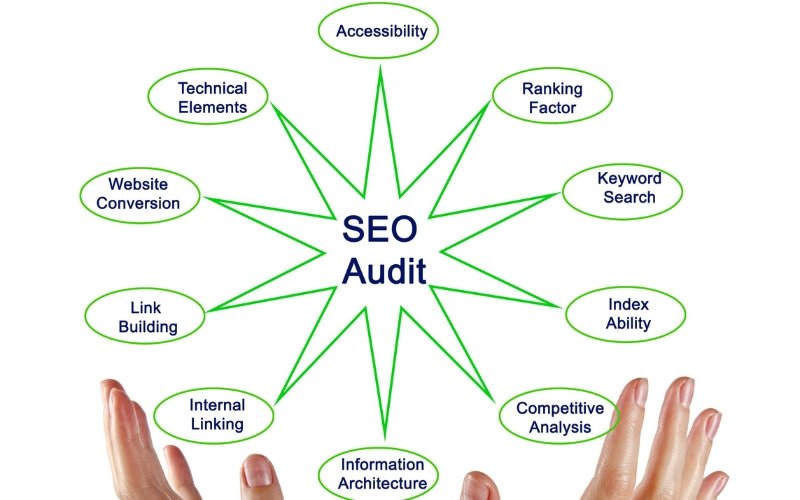A successful SEO strategy begins with a comprehensive SEO audit. Without this crucial first step, any attempt to improve a website’s search engine rankings is like navigating without a map. A thorough audit helps to identify current issues, opportunities for improvement, and the website’s overall performance in search engines. This guide will explain the importance of a comprehensive SEO audit and how it lays the groundwork for future success.
What Is an SEO Audit?

An SEO audit is a comprehensive SEO audit of a website’s overall performance in search engine rankings. It involves a detailed analysis of various factors that influence a website’s visibility on search engine result pages (SERPs). These factors include technical SEO, on-page optimization, and off-page elements like backlinks and domain authority. The purpose of an SEO audit is to uncover problem areas that might be preventing your website from achieving its full potential in search rankings.
A comprehensive SEO audit looks at everything from page load times and broken links to content quality and user experience. It identifies issues that may be hindering your site’s performance, such as slow-loading pages, missing meta tags, or duplicate content. By addressing these issues, you can improve your website’s visibility, attract more traffic, and ensure that your site is fully optimized to meet the latest search engine algorithms.
Why Is a Comprehensive SEO Audit Essential?
Search engines like Google continuously update their algorithms to enhance the quality of search results. Factors like mobile-friendliness, page speed, and content relevance are now critical to ranking well. Without a comprehensive SEO audit, your website could be left behind, failing to capitalize on potential traffic and leads.
An SEO audit is not just a one-time process. Regular audits ensure that your website remains aligned with current SEO best practices. For example:
- Algorithm Changes: Google makes frequent updates to its algorithms, such as prioritizing mobile-friendly sites or emphasizing page experience. A comprehensive SEO audit ensures your site keeps pace with these changes.
- Competitor Analysis: Your competitors are likely optimizing their sites regularly. Without an audit, you risk losing ground to competitors who have identified and resolved their SEO issues.
- Technical Issues: Technical problems like crawl errors, 404 pages, or slow page speeds can significantly impact your rankings. An audit brings these issues to light, allowing you to fix them before they harm your site’s performance.
Components of a Comprehensive SEO Audit

A comprehensive SEO audit typically includes the following elements:
Technical SEO Analysis
This involves evaluating the backend elements of your website that affect its crawlability and indexing. Key aspects include:
- Crawl Errors: Identifying pages that search engines cannot access.
- Page Speed: Ensuring fast load times for a better user experience.
- Mobile-Friendliness: Checking if your site is optimized for mobile users.
- XML Sitemap: Ensuring your sitemap is correctly configured to help search engines index your site.
A technical audit ensures that search engines can easily access and understand your site, which is critical for improving rankings.
On-Page SEO Analysis
This focuses on the elements you can control directly on your website, such as:
- Keyword Optimization: Ensuring target keywords are effectively integrated into titles, headings, and content.
- Meta Tags: Checking for missing or duplicate meta titles and descriptions.
- Content Quality: Evaluating the relevance, readability, and originality of your content.
- Internal Linking: Ensuring a logical and user-friendly internal linking structure.
On-page SEO improvements play a vital role in optimizing your content to rank higher and provide a better experience for users.
Off-Page SEO Analysis
Off-page SEO examines external factors that impact your website’s authority and reputation, including:
- Backlink Profile: Analyzing the quality and quantity of backlinks pointing to your site.
- Domain Authority: Assessing your website’s authority compared to competitors.
- Social Signals: Checking how your website is performing across social media platforms.
A comprehensive SEO audit ensures that your website builds trust and authority, which are critical factors in ranking well on SERPs.
User Experience (UX) Evaluation
User experience is a key ranking factor in modern SEO. This part of the audit evaluates:
- Navigation: Ensuring your site is easy to navigate and user-friendly.
- Content Engagement: Analyzing metrics like bounce rate and time on page.
- Design: Checking for a responsive design that adapts seamlessly to all devices.
A better user experience not only improves rankings but also boosts engagement and conversions.
Steps to Conduct a Comprehensive SEO Audit
Performing a comprehensive SEO audit involves several key steps:
- Step 1: Use SEO Tools
Start with tools like Google Search Console, Google Analytics, and third-party platforms such as SEMrush or Ahrefs. These tools provide valuable insights into your website’s health and performance.
- Step 2: Analyze Technical SEO
Run a crawl of your site using tools like Screaming Frog to identify technical issues. Fix errors such as broken links, redirect chains, or missing alt text.
- Step 3: Evaluate Content
Examine your website’s content for relevance and quality. Ensure that your content is unique, provides value to the reader, and targets the right keywords.
- Step 4: Assess Backlink Quality
Use a tool like Ahrefs to analyze your backlink profile. Disavow toxic or spammy links that could harm your site’s authority.
- Step 5: Optimize for Mobile
With mobile-first indexing, ensuring your site is fully optimized for mobile users is essential. Test your site’s mobile performance using Google’s Mobile-Friendly Test.
Benefits of a Comprehensive SEO Audit
A comprehensive SEO audit offers several advantages that can transform your website’s performance:
- Improved Rankings
By identifying and fixing technical and content-related issues, your site becomes more attractive to search engines. This leads to higher rankings and increased visibility.
- Increased Traffic
Optimizing your site for target keywords and improving user experience results in more organic traffic. A well-optimized site also has a higher chance of appearing in featured snippets and other rich results.
- Better User Experience
An SEO audit ensures that your website is fast, mobile-friendly, and easy to navigate, creating a seamless experience for users. This not only improves engagement but also increases the likelihood of conversions.
- Enhanced ROI
By addressing weaknesses in your site, a comprehensive SEO audit ensures that your marketing efforts yield better returns. Higher traffic and conversions translate to increased revenue.
How Often Should You Conduct an SEO Audit?
A comprehensive SEO audit should ideally be conducted every 6 to 12 months. Regular audits help you stay ahead of algorithm updates, monitor your site’s health, and keep up with the competition. For websites undergoing significant changes, such as redesigns or major content updates, audits should be performed more frequently
Key Elements of a Comprehensive SEO Audit

Technical SEO Technical SEO is the foundation of any website’s performance. It focuses on how well search engine bots can crawl and index a website. A technical SEO audit typically includes:
Crawlability: Checking if search engines can access all parts of the website.
Indexing: Ensuring that important pages are indexed correctly in Google.
Site Speed: Analyzing page load times to improve user experience and ranking potential.
Mobile Friendliness: Verifying that the website is optimized for mobile devices, as mobile-first indexing is now a priority for Google.
Security: Making sure the website has HTTPS enabled, which helps build trust with users and is a Google ranking factor.
On-Page SEO On-page SEO involves optimizing elements within a website to help it rank higher. Key aspects of an on-page audit include:
Meta Titles and Descriptions: Reviewing and optimizing meta tags to ensure they are concise, keyword-rich, and informative.
Header Tags: Proper use of H1, H2, and H3 tags to structure content, making it easy for users and search engines to understand.
Alt Text for Images: Ensuring all images have relevant alt text to improve accessibility and search visibility.
Internal Linking: Examining the internal link structure to guide users and search engines through important pages effectively.
Content Analysis Content is critical to SEO success. During the audit, we analyze the quality, relevance, and keyword usage of the content on the website. It’s essential to ensure that the content:
Is relevant to the target audience and offers value.
Incorporates targeted keywords naturally.
Is free of duplicate content, which can lead to penalties from search engines.
User Experience A significant factor in modern SEO is user experience. Google’s algorithms now focus on how users interact with websites. Important factors in this area include:
Bounce Rate: Monitoring how quickly users leave the website and identifying areas for improvement.
Page Layout: Ensuring the site is easy to navigate and aesthetically pleasing.
Backlink Profile Backlinks are still a major ranking factor, so a review of the website’s backlink profile is crucial. We identify and disavow any toxic backlinks that could be harming the website’s credibility.
Conclusion
A comprehensive SEO audit is the cornerstone of a successful SEO strategy. By identifying and addressing technical, on-page, and content-related issues, businesses can improve their website’s performance, enhance user experience, and ultimately boost search engine rankings. A regular SEO audit ensures that a website remains competitive and well-optimized in the ever-changing digital landscape.

